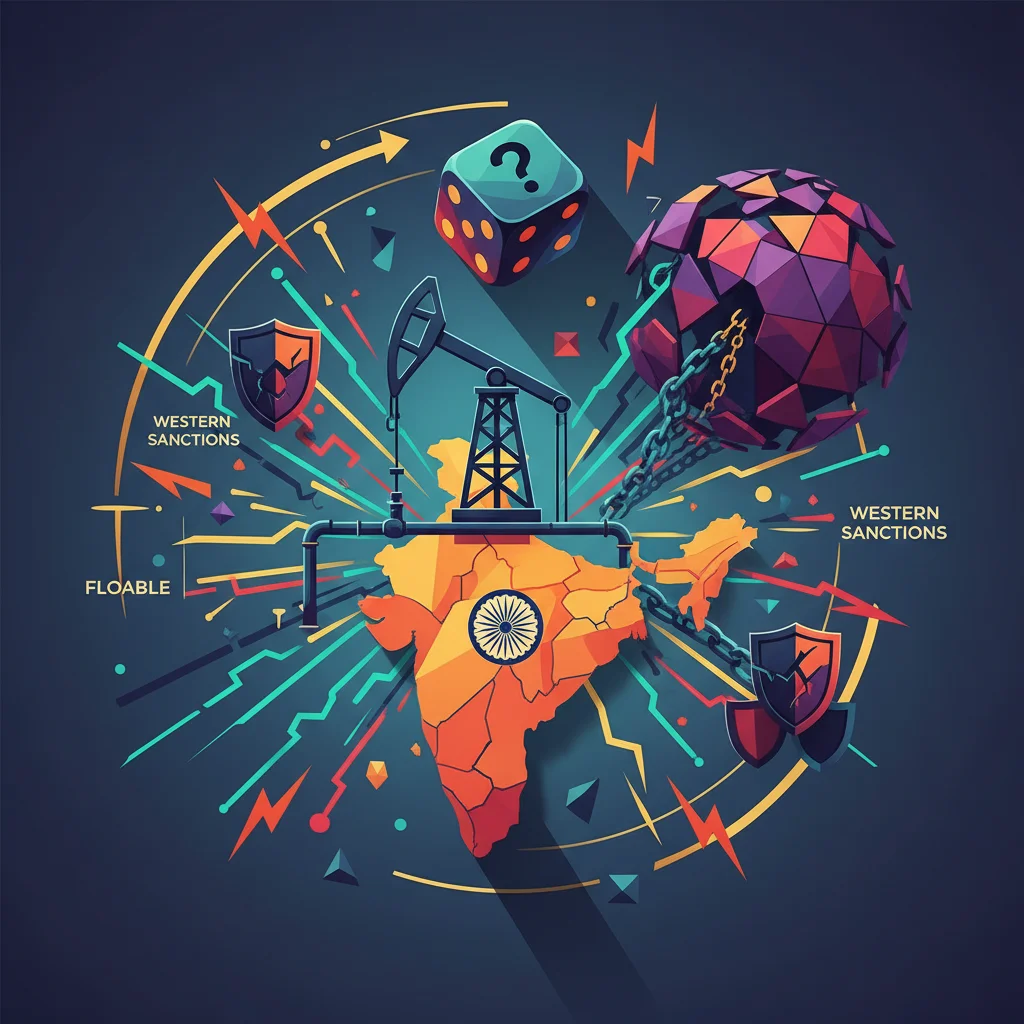
The Great Energy Gamble: Why India’s Russian Oil Strategy Is a High-Stakes Play for the Global Economy
In the intricate ballet of global geopolitics and finance, few moves are as bold or as closely watched as India’s persistent procurement of Russian crude oil. Despite a complex web of Western sanctions and the looming shadow of a potential second Trump presidency threatening stricter enforcement, New Delhi has not only continued its energy trade with Moscow but has solidified its position as a primary buyer. This strategic defiance is more than just an economic transaction; it’s a defining statement about India’s rising influence, its pragmatic foreign policy, and the shifting fault lines of the global economic order.
For investors, finance professionals, and business leaders, understanding the nuances of this situation is critical. It’s a live case study in geopolitical risk, supply chain resilience, and the future of international trade. As we delve into the mechanics of this high-stakes energy play, we’ll also explore parallel developments in digital regulation and glean wisdom from industry leaders on navigating this volatile landscape.
The Economic Rationale: Fueling a Nation Amidst Global Headwinds
At its core, India’s decision is driven by a powerful economic imperative. As the world’s third-largest oil importer and consumer, India’s economy is exquisitely sensitive to fluctuations in energy prices. The war in Ukraine sent global crude prices soaring, presenting a significant threat to India’s post-pandemic recovery and its efforts to control inflation. Russian oil, offered at a significant discount, became an economic lifeline.
This strategy has yielded tangible benefits for the Indian economy. Access to cheaper crude has helped the government manage its import bill, stabilize the rupee, and keep domestic fuel prices in check, thereby taming inflationary pressures that have plagued other major economies. According to some reports, these purchases have saved India billions of dollars, providing crucial fiscal headroom. The move has been instrumental in powering India’s continued GDP growth, making it one of the fastest-growing major economies in the world.
This trade relationship is not just about discounts; it’s also about diversifying energy sources and payment mechanisms. Much of this trade is reportedly being settled in currencies other than the US dollar, such as the UAE dirham and, to a lesser extent, the Indian rupee. This trend, while still nascent, nibbles at the edges of the dollar’s dominance in global energy trading—a development with long-term implications for the international financial system and the future of banking.
Navigating the Sanctions Labyrinth
India’s ability to maintain this trade hinges on its careful navigation of the G7’s price cap mechanism. The cap, set at $60 per barrel, was designed to limit Russia’s war revenue while keeping its oil on the global market to prevent a price shock. It prohibits Western companies involved in shipping, finance, and insurance from facilitating the trade of Russian seaborne crude unless it is sold at or below this price.
India has officially maintained that its purchases adhere to this cap. However, the effectiveness of the cap has been widely debated. A “shadow fleet” of older tankers with opaque ownership and non-Western insurance has emerged to transport Russian oil, often at prices above the cap. This complex logistical network has allowed the trade to flourish, showcasing the limitations of sanctions in a multipolar world where major economic powers like India and China prioritize their national interests.
To better understand the strategic calculus, let’s examine the key factors influencing India’s decision-making process.
| Strategic Advantages for India | Geopolitical and Financial Risks |
|---|---|
| Economic Stability: Access to discounted crude oil helps control inflation, reduces the trade deficit, and supports robust economic growth. | US Sanctions Risk: A potential Trump administration could impose secondary sanctions on Indian entities, including banks and refineries. |
| Energy Security: Diversifies oil import sources away from traditional Middle Eastern suppliers, increasing national energy resilience. | Strained Western Relations: Creates diplomatic friction with the US and European partners who advocate for a unified stance against Russia. |
| Strategic Autonomy: Reinforces India’s foreign policy of non-alignment, allowing it to engage with both Western and non-Western powers on its own terms. | Financial System Exposure: Reliance on non-dollar settlement and non-Western shipping/insurance introduces operational and compliance risks into the financial technology and banking sectors. |
| Strengthened Russian Ties: Deepens a long-standing partnership with a key supplier of military hardware and a partner in multilateral forums like BRICS. | Market Volatility: Any sudden crackdown or change in US policy could disrupt supply chains and cause significant volatility in India’s stock market, particularly in the energy and finance sectors. |
This balancing act is a masterclass in modern statecraft, but it is not without its perils. The most significant of these is the political uncertainty emanating from the United States.
India's Banking Megamerger: Forging Global Titans or 'Too Big to Fail' Giants?
The Trump Variable: A Sword of Damocles?
The original Financial Times report highlights a critical uncertainty: the potential for a dramatic policy shift under a second Donald Trump presidency. While the Biden administration has taken a relatively pragmatic approach—publicly discouraging the purchases while tacitly accepting them to prevent a global oil price spike—a Trump White House could adopt a far more aggressive and transactional stance.
A new administration might view the situation not through the lens of global market stability but through a more isolationist “America First” framework, potentially leading to the imposition of secondary sanctions. Such sanctions could target Indian financial institutions, refineries, and shipping companies involved in the trade, creating significant disruption. The mere threat of such actions could be enough to force Indian companies to reconsider their exposure, impacting everything from international banking relationships to stock market valuations of energy giants.
A Parallel Shift: India’s New Digital Privacy Frontier
While the energy markets grab headlines, another seismic shift is occurring within India’s domestic regulatory landscape. The newsletter also noted that a comprehensive digital privacy law is “finally here.” This refers to the Digital Personal Data Protection Act (DPDP Act) of 2023, a landmark piece of legislation that is set to redefine the rules of the road for any business handling the data of Indian citizens.
For the burgeoning fintech, e-commerce, and technology sectors, this is a pivotal moment. The law introduces new compliance obligations regarding data collection, processing, and storage, akin to Europe’s GDPR but tailored to the Indian context. Key provisions include stricter consent requirements, the right for individuals to have their data erased, and the establishment of a Data Protection Board to handle enforcement and penalties.
The implications are profound:
- For Fintech and Banking: Financial technology firms and banks, which thrive on data analytics for everything from credit scoring to personalized services, will need to overhaul their data governance frameworks. This requires significant investment in compliance technology and processes.
- For Investors: When evaluating tech and fintech companies, due diligence on DPDP Act compliance will become non-negotiable. Companies that are proactive in building robust privacy-centric systems will likely command a premium and face lower long-term regulatory risk.
- For Blockchain and Web3: The principles of data minimization and the right to be forgotten present interesting challenges and opportunities for blockchain-based applications, where data is often immutable. This could spur innovation in privacy-preserving financial technology.
Echoes of '97: Is Labour Repeating Blair's Greatest Economic Gamble?
Leadership in Turbulence: The Mantra of Pranav Haridasan
In a world defined by such complex economic and regulatory crosscurrents, the perspective of those at the helm of business is invaluable. The source mentions the “mantra” of Pranav Haridasan, co-founder of Axis Bank’s enterprise accelerator. While the exact mantra isn’t detailed, his work focuses on nurturing startups that can scale in challenging environments. A guiding principle emerging from such leaders often revolves around a simple but powerful idea: “Build for resilience, not just for growth.”
This mantra is the perfect lens through which to view the preceding topics. India’s energy strategy is a national-level application of this principle—securing a resilient energy supply to protect economic stability, even if it means sacrificing some diplomatic comfort. For businesses grappling with the new DPDP Act, it means building resilient data systems that can withstand regulatory scrutiny and evolving consumer expectations.
For those in finance and trading, it means constructing resilient portfolios that can absorb geopolitical shocks and market volatility. The era of straightforward, growth-at-all-costs economics is giving way to a more nuanced appreciation for durability, diversification, and strategic foresight.
The 0 Million Handshake: Decoding Goldman Sachs' Record-Breaking EA Deal
Conclusion: Charting a Course in a Multipolar World
India’s unwavering commitment to purchasing Russian oil is far more than a footnote in energy market reports; it is a bellwether for a new era of global economics. It signals a world where major emerging powers are increasingly willing to chart their own course, driven by national interest and a pragmatic assessment of their strategic options. This creates a more complex and fragmented landscape for international finance, investing, and trade.
For business leaders and investors, the key is not to fear this complexity but to understand it. The interconnectedness of geopolitical maneuvering, economic policy, and technological regulation means that a siloed approach is no longer viable. Whether analyzing the stock market, a fintech startup, or a global supply chain, one must now be part strategist, part economist, and part political analyst. India’s high-stakes energy gamble is a stark reminder that in the 21st-century economy, the biggest risks and the greatest opportunities lie at the intersection of power and profit.

